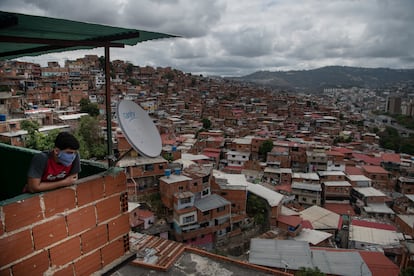Venezuela’s economic crisis has led to a surge in suicides
From 2015 to 2018, the rate rose from 3.8 to 9.3 per 100,000 inhabitants; men between the ages of 30 and 64 and youths between 15 and 24 are the most at risk


On a weekend in May, a 15-year-old boy and a 37-year-old man both jumped to their deaths off a viaduct in Mérida. Nearly 40% of Venezuela’s suicides happen in this mountain city south of oil-rich Lake Maracaibo. After a brief lull, suicides seem to be on the rise again in 2023. According to local media reports, the Venezuelan Observatory of Violence (OVV) has recorded 162 suicides and 32 attempts as of mid-May.
The scarcity of public data, combined with the increasing number of unreported deaths attributed to suicide (estimated to be at least 49% of cases), has made it challenging to comprehensively analyze the suicide rate, which has been on the rise over the past two decades per official reports. But data from individual researchers is alarming. “With 1.2 suicides occurring every day, the number of cases is projected to surpass 400 by the end of the year, a figure that exceeds previous years. Self-inflicted violence in Venezuela is marching in lockstep with the humanitarian crisis,” says Gustavo Páez, the OVV director in Mérida.
While Venezuela doesn’t rank at the top when it comes to suicide rates in South America (Guyana, Surinam, Bolivia and Uruguay have higher rates), it has nonetheless seen a significant increase over the past few years. Between 2015 and 2018, the suicide rate rose from 3.8 to 9.3 per 100,000 inhabitants; men aged 30-64 and youths aged 15-24 are the most at risk. While there has been a slight decline in the past two years due to outbound migration and a slight economic uptick, the rate still hovers around eight per 100,000 inhabitants. Experts say a major cause is the economic crisis that has shrunk the oil-rich country’s economy by 66% in less than a decade, increasing inequality and affecting the mental well-being of its people.
While acknowledging that suicide is a complex issue with underlying factors such as individual, family and social conditions, Paéz warns that the stubborn economic crisis will result in more suicides in 2023. “If the current situation worsens, we can expect an increase in suicide rates. Last year, we saw some signs of recovery because of progress in reducing hyperinflation. Unfortunately, we find ourselves facing yet another economic slump in 2023. As a result, we are witnessing a steady stream of people leaving the country through the Darién region. The ongoing humanitarian crisis, the combination of individual and family factors, and the general erosion of mental health among Venezuelans are all contributing to the situation.”
A recent study by the Andrés Bello Catholic University in Caracas provides insights into Venezuela’s national mood. Conducted in late 2022 and early 2023, the survey revealed that an overwhelming 90% of the country’s citizens are concerned about its current situation. Furthermore, 79% are experiencing anger about it and 73% are deeply saddened by the country’s uncertain future. Four out of 10 Venezuelans say they feel discouraged by the crisis. According to the study, 64% reported stress and insecurity due to economic hardships. The emotional toll of death and mass emigration is also eroding the emotional well-being of those left behind.
Páez has just completed a study based on interviews with family members and others connected to 80 suicides in 17 rural municipalities around Mérida, an area that has become the country’s suicide hotspot. In at least 21.6% of the cases studied, the main suicide risk factors were financial losses, poverty, unemployment, inability to meet basic needs and migration of family members.
Other major risk factors include problems with romantic partners, depression and anxiety disorders, and easy access to the toxic agrochemicals that are prevalent in this agricultural region. The principal risk factors are rounded out by domestic violence and bullying due to sexual orientation and gender identity.
Mérida is no stranger to the crisis affecting all Venezuelans. It sits in one of the country’s Andean states hit hard by blackouts and fuel shortages. People line up for days to buy a few gallons of gasoline, a common sight outside the bubble of Caracas. “Living in Mérida can be extremely frustrating for people whose patience is tested several times a day,” says psychiatrist Stefany Pinto, who runs a support group for people with suicidal thoughts. Sponsored by the Movimiento Somos NGO, the group sessions draw 30-50 people on a regular basis.
“The humanitarian crisis continues to be a problem that’s most noticeable outside the capital. There are many unaddressed issues related to the pandemic and the crisis,” says Jau Ramírez, who leads an LGBTQ+ advocacy organization that has launched support groups in cities like San Cristóbal, Maracaibo and Caracas. The University of the Andes in Mérida has seen 60% of its students drop out in the last five years, undermining the local economy and morale. “Risk factors for suicide can range from financial need to an HIV diagnosis to gender violence. We had one recent case of a lesbian girl who lived in a homophobic environment. This is not talked about in our society,” adds Ramírez.
About 20 years ago, the regional government built barriers around one of Mérida’s viaducts, naively hoping to prevent people from jumping off what was once a steep, scenic overlook. But Mérida has two other viaducts with no barriers to stop people from jumping. The recent surge in suicide leaps has led the local government to deploy police, firefighters and religious groups to these bridges in a misguided attempt at preventing more deaths.
To people working on the suicide problem, these measures are counterproductive, especially since mental health specialists are scarce and often unaffordable for people in poor countries where public health care is severely limited. The nation’s ailing economy — the main source of stress for Venezuelans — is again to blame. “Someone with $20 in his wallet will buy food instead of paying for a visit to a psychiatrist,” says Páez.
Sign up for our weekly newsletter to get more English-language news coverage from EL PAÍS USA Edition
Tu suscripción se está usando en otro dispositivo
¿Quieres añadir otro usuario a tu suscripción?
Si continúas leyendo en este dispositivo, no se podrá leer en el otro.
FlechaTu suscripción se está usando en otro dispositivo y solo puedes acceder a EL PAÍS desde un dispositivo a la vez.
Si quieres compartir tu cuenta, cambia tu suscripción a la modalidad Premium, así podrás añadir otro usuario. Cada uno accederá con su propia cuenta de email, lo que os permitirá personalizar vuestra experiencia en EL PAÍS.
¿Tienes una suscripción de empresa? Accede aquí para contratar más cuentas.
En el caso de no saber quién está usando tu cuenta, te recomendamos cambiar tu contraseña aquí.
Si decides continuar compartiendo tu cuenta, este mensaje se mostrará en tu dispositivo y en el de la otra persona que está usando tu cuenta de forma indefinida, afectando a tu experiencia de lectura. Puedes consultar aquí los términos y condiciones de la suscripción digital.
More information

Living through ‘the same hell twice’: Crisis hits Venezuelans who fled to Lebanon
Archived In
Últimas noticias
Most viewed
- Sinaloa Cartel war is taking its toll on Los Chapitos
- Oona Chaplin: ‘I told James Cameron that I was living in a treehouse and starting a permaculture project with a friend’
- Reinhard Genzel, Nobel laureate in physics: ‘One-minute videos will never give you the truth’
- Why the price of coffee has skyrocketed: from Brazilian plantations to specialty coffee houses
- Silver prices are going crazy: This is what’s fueling the rally









































